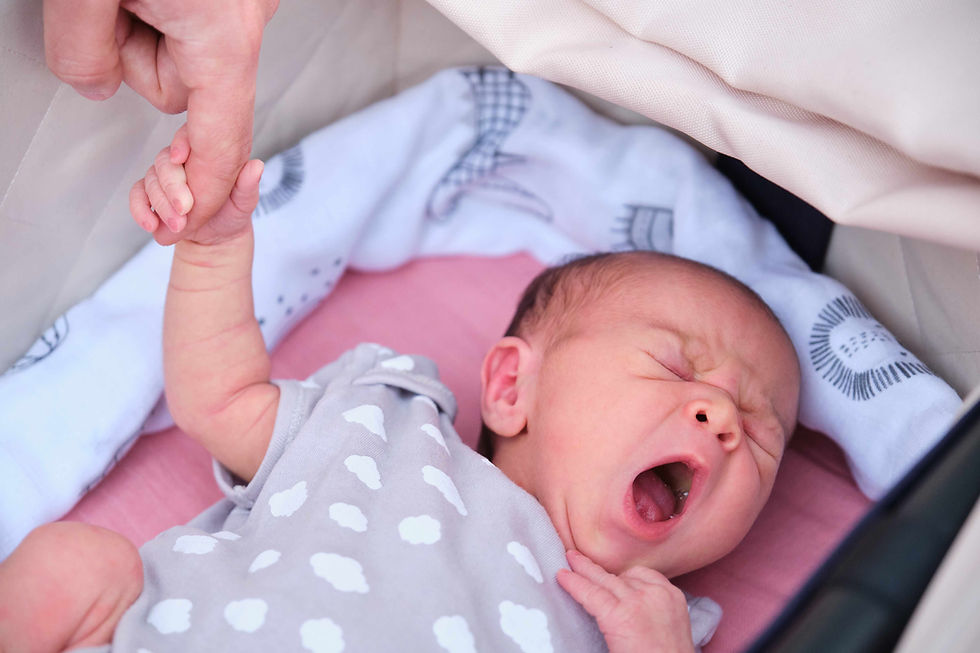What is Your Baby Telling You?
- CPBF

- Aug 11
- 4 min read
The NICU can be an overwhelming environment. It can be hard to focus on anything but the beeping of monitors and medical conversations. Did you know that amid the NICU hustle and bustle, your baby is talking to you? Learn how to tune in and better understand your baby’s language.
Cues: what they are and why they matter
Cues are signs that we can observe that help us understand what a baby needs. For example, crying is a cue. A baby’s cry tells us that something is wrong (like they are hungry) or that they need something (like a soothing touch). Many baby cues are more subtle than crying and take a little practice to recognize.
Baby cues can include:
Behaviours (like yawning, gazing, looking away)
Movements (like stiffening or pushing away from a bottle)
Facial expressions (like grimacing or looking relaxed)
Vital signs (like changes in breathing, heart rate or oxygen levels)

A baby’s cues can be a wealth of information. No matter what we are doing with a baby (for example, reading to them, singing or getting ready for a feed), their cues can help us determine if they are happy and content, or if they need a break.
Cues that your baby is calm and ready for interaction
When you are ready to interact with your baby, read them a book or offer them a breast or bottle feed, look for cues that indicate your baby is calm and ready for interaction. It is normal for babies to take some time and need a little help to transition into a calm state. You can help them by offering a pacifier (non-nutritive sucking), bringing their arms and legs close to their body and talking to them in a soft, soothing voice.
Signs your baby is content and ready for interaction include:
A relaxed posture with arms relaxed and hands near their face
A bright and alert gaze
A calm facial expression
What to do when your baby is calm and content
If your baby is showing cues that they are calm and content, they may be ready for more interaction. This is a perfect time to read them a book, sing to them or talk to them (for more information about the benefits, check out our blog post about language development).
Signs that your baby may need a break
Just like babies can tell us they are calm and content, they can also let us know when they are feeling stressed and need a break. It may seem obvious that a crying baby is unhappy, but cues that a baby needs a break may be much more subtle.
Every baby will have moments when they have had enough, even if they were relaxed moments earlier. If a baby shows signs of stress, it does not mean you did something wrong.
Watch for these signs to know when your baby needs a break:
Movement signs.
Flailing their arms and legs
Making their legs straight or stiff
Arching their back
Putting their arm out straight with fingers spread (also known as a “stop hand”)
Facial expressions and other signs on their face
Grimaces and frowns
Furrowed brow or worried look
Yawning, sneezing
Turning away and avoiding eye contact
A wide-eyed stare that they can’t break (when it seems like they can’t look away)
Alertness
Sudden changes from alert to drowsy
Crying and fussiness that are difficult to soothe
Being “hyper-alert” (can’t look away)
Medical cues (let your nurse know if you see these signs):
changes in colour (pale, blue)
changes in breathing, heart rate or oxygen levels
What to do if your baby shows cues that they need a break
If your baby is showing signs of stress or needs a break, sometimes a little help can quickly return them to a calm state. Try these strategies to soothe and support your baby:
Give them a hand hug (also known as a facilitated tuck) by placing one hand on their head and the other on their knees or stomach.
Hold them skin to skin for kangaroo care for some quiet time
Dim the lights (or cover their eyes with your hand or a cloth)
Offer a pacifier (but don’t force it if they are not interested)
Bring their hands towards their face (this helps them self-soothe)
Feeding Cues
Babies also show us when they are hungry and ready to eat. If your baby is very premature, they may start showing these signs before they are mature enough to feed by breast or bottle.
If your baby is working on breast or bottle feeds, watch for these cues to know that it may be a good time for your baby to feed:
bringing hands to mouth
rooting (turning their head to the side with an open mouth)
mouth opening, lip licking and sucking
fussiness and eagerness to suck
Click here to watch an excellent video from Healthlink BC that shows baby feeding cues.
Recognizing your baby's cues takes some practice. Ask your baby’s nurse or occupational therapist to show you if you are unsure. Respecting your baby’s cues is a great way to help your baby during their NICU stay and beyond!
Resources
Learning your baby’s cues. March of Dimes. https://www.marchofdimes.org/find-support/topics/neonatal-intensive-care-unit-nicu/learning-your-babys-cues
Social and emotional development in a baby’s first year. AboutKidsHealth - the Hospital for Sick Children (SickKids). 2024. https://www.aboutkidshealth.ca/social-and-emotional-development-in-a-babys-first-year
Baby cues and baby body language: video guide. Raising Children Network. 2022. https://raisingchildren.net.au/newborns/connecting-communicating/communicating/baby-cues
Pineda R, Guth R, Herring A, Reynolds L, Oberle S, Smith J. Enhancing sensory experiences for very preterm infants in the NICU: an integrative review. Journal of Perinatology. 2016 Oct 20;37(4):323–32. https://pmc.ncbi.nlm.nih.gov/articles/PMC5389912/
Getting Started – feeding cues. HealthLink BC. https://www.healthlinkbc.ca/search?kw=getting+started+feeding+cues




Comments